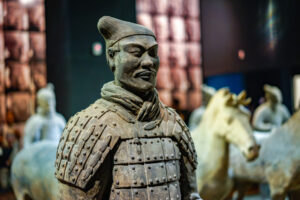Looking for something that will stand the test of time? You’ll be hard-pressed to find something more enduring than terracotta. As one of the world’s most recognisable materials, it has been a key feature in artwork, pottery and architecture for thousands of years. And it’s not going anywhere in a hurry.
Join us as we explore terracotta’s colourful history in more depth below!
What Is Terracotta?
Terracotta is a porous clay that can be manipulated into many different shapes. After it has been sculpted, it is then fired in a kiln or left to harden in the sun. Terracotta’s literal translation – ‘baked earth’ – gives us the perfect window into its creation.
Once hardened, terracotta will take on a distinctive rust-like appearance and assume any number of impressive shades. Its characteristic orange-red hue comes about as a result of a natural reaction to oxygen, with the addition of a glaze further enhancing its rich, earthy colour.
Famous Terracotta Pieces
Historically, terracotta was a big part of many ancient cultures, with Egyptian, Greek and Minoan civilisations (amongst others) frequently using it in their architectural, artistic and homeware creations.

The most famous application of this material is probably The Terracotta Army, an awe-inspiring collection of clay warriors who were charged with overseeing the final resting place of Chinese Emperor Qin Shi Huang. Both military and non-military terracotta figures were identified during archaeological digs in the 1970s, and the total number of statues is believed to be somewhere in the region of 8,000!
Just as inspiring is the Venus of Dolni Vestonice, the world’s earliest example of terracotta artwork, which was discovered in what is now the Czech Republic in 1925. This piece depicts the naked female form and is one of the oldest ceramic objects in the world.
Despite being so revered in the ancient world, terracotta endured a lengthy spell on the sidelines after the fall of the Roman Empire. It eventually re-emerged as a popular artistic medium during the Renaissance and has been used in various applications ever since. Its influence was perhaps most notable during the Victorian era, where it was a favourite of many prominent architects. If you look closely enough, you’ll even be able to spot terracotta buildings dotted around many parts of London, Birmingham and Manchester today.
What Are The Advantages Of Terracotta?

As well as being incredibly attractive, terracotta has many other positive attributes. When in its purest form, it is easy to work with and can be shaped with considerably less effort than tougher materials like bronze or marble. Terracotta clay also has a low firing cost, which means that objects made from terracotta require less energy to produce and can endure quick changes in temperature without breaking.
Terracotta’s astonishing durability is the very reason it has been relied upon for so long. The fact it is still so popular speaks for itself.
Contemporary Terracotta Planters And Water Features At Taylor Made Planters
Now that you’ve explored the history, why not add an old-world twist to your backyard with contemporary terracotta planters and external water features made from Taylor Made Planters? Our wide selection of outdoor essentials includes many striking terracotta designs, giving you everything you need for that wonderful, one-of-a-kind garden centrepiece.
Browse our range of hand-thrown terracotta plant pots to discover the perfect vessel for your plants, shrubs and trees. Each one has been carefully manufactured on the Island of Crete and will provide an environment that’s extremely conducive to healthy plant growth. Some can even be turned into luxurious, high-quality water features to keep up that classic style.
Lentas
Explore our modern planters and contemporary water features to find your dream terracotta piece at Taylor Made Planters.
Got further questions about our terracotta planters or any of our other products? Get in touch with a member of our team today!





















